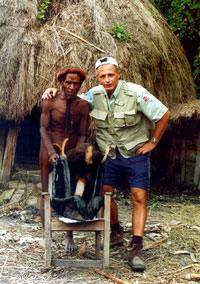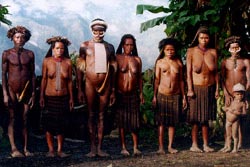Trekking into prehistory
"Grabbing a once in a lifetime chance, Philippe set out to discover more about the remote and ancient culture of the Dani people in Indonesia's easternmost province."
Philippe Montaggioni
Senior Geologist
There is no doubt that my trek of Spring 1999 in the highlands of the Baliem valley in Irian Jaya was the most incredible experience of my life so far: a real plunge into the prehistory of humanity. Both Irian Jaya and the rest of New Guinea island are some of the last places on earth where you can still meet people living as their ancestors did in the Stone Age.
Of the hundreds of Papuan tribes of Irian Jaya the most distinguished are the highlanders, who are the only ones to wear a very unique piece of "clothing", the traditional keteka–a penis sheath made of gourd. Depending on ethnic affiliation, the koteka may differ in shape, volume and length, but it is always worn in "present arms" position.
Irian Victorious!
Irian Jaya, Indonesia’s easternmost province, makes up about half of the island of New Guinea; the other half being the independent state of Papua New Guinea. When the Portuguese first sighted the island, they called it Ilhas dos Papuas (‘the island of the fuzzy hairs’) from the Malay word papuwah. Later Dutch explorers called it New Guinea because the black-skinned people reminded them of the people of Guinea in Africa.

Philippe with a Dani Warrior and mummy
 |
 |
|
Dani Family |
Irian is a word from the Biak language, and means "hot land rising from the sea". Under the Dutch, Irian Jaya was known as Dutch New Guinea and when sovereignty transferred to Indonesia, it was renamed Irian Jaya (jaya means "victorious").
The first white men chanced upon the Baliem valley in 1938, a discovery that came as one of the last and greatest surprises to a world that thought it had mapped, studied and traveled its remotest corners. It wasn’t until 1945 that attention was again drawn to the valley when a plane crashed there and the survivors were rescued. The first missionaries arrived in 1954, the Dutch government established a post at Wamena in 1956, and changes to the Baliem valley followed. Today Wamena, the starting point of my trek, is a sprawling, haphazard Indonesian town, but local culture has in many ways proved very resilient.
The contrast of naked Dani walking on their way to the city market or heading back to their remote villages (often several walk days away in the mountains) and the "modern" Indonesian people driving their noisy motor-bikes or mini buses brought by cargo plane at great expense, is the first cultural shock experienced by the traveller when getting out of the airport. These Indonesian migrants are mostly muslim Javanese people who run, almost exclusively, the local businesses and the administration. Very few Dani people actually speak Indonesian, another proof that these two worlds are still nowadays living side by side several thousands of years apart and not blending together.
This content has been re-published with permission from SEED. Copyright © 2025 Schlumberger Excellence in Education Development (SEED), Inc.



